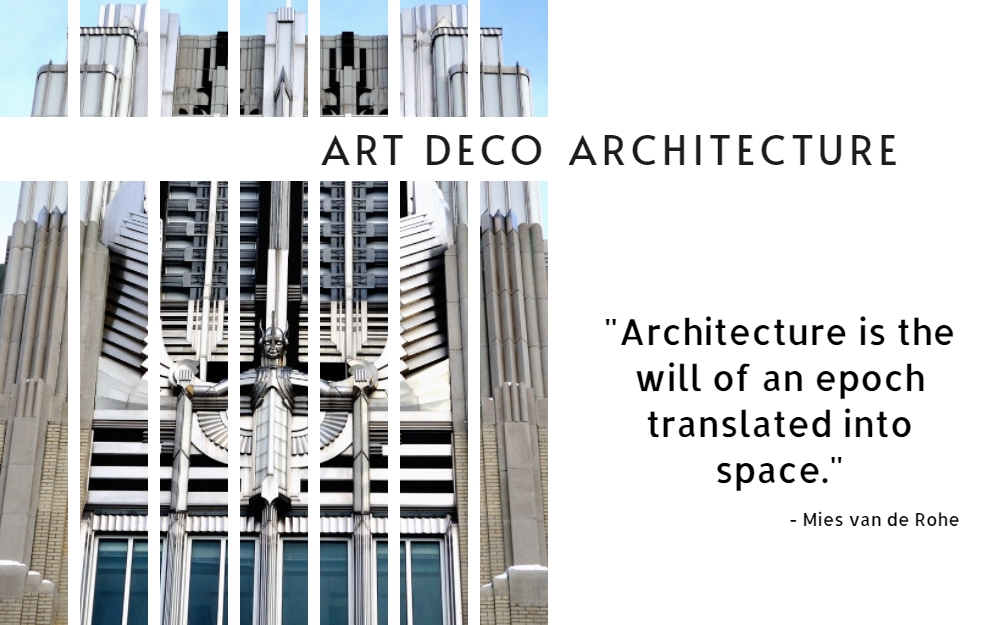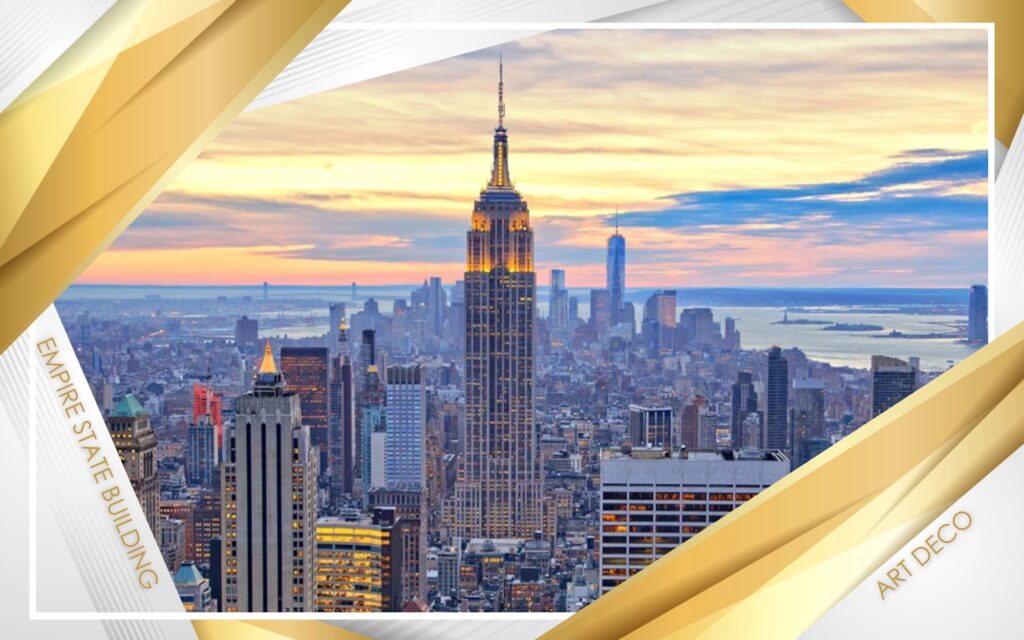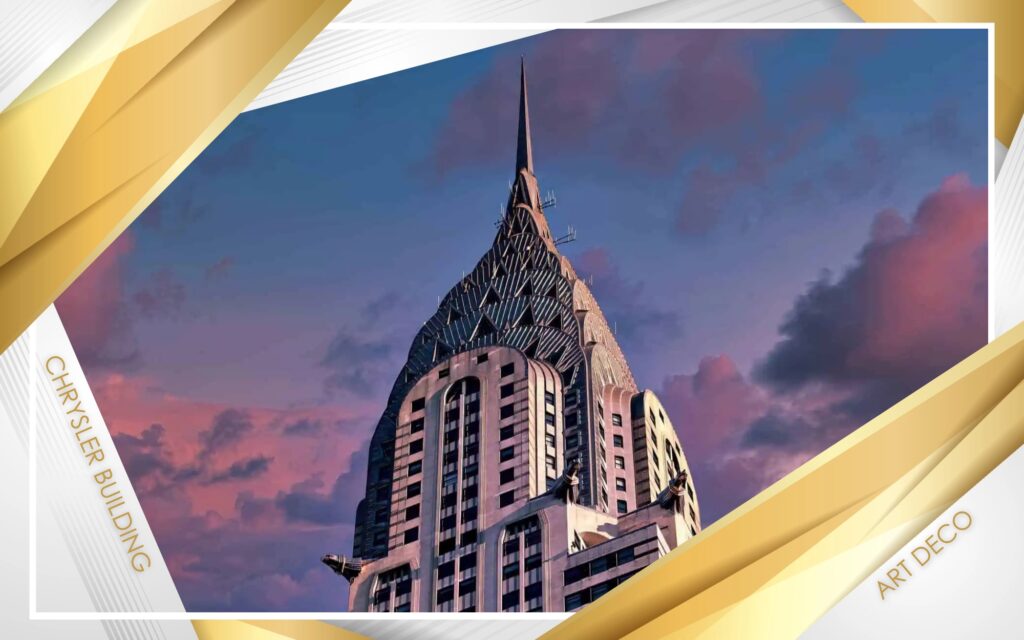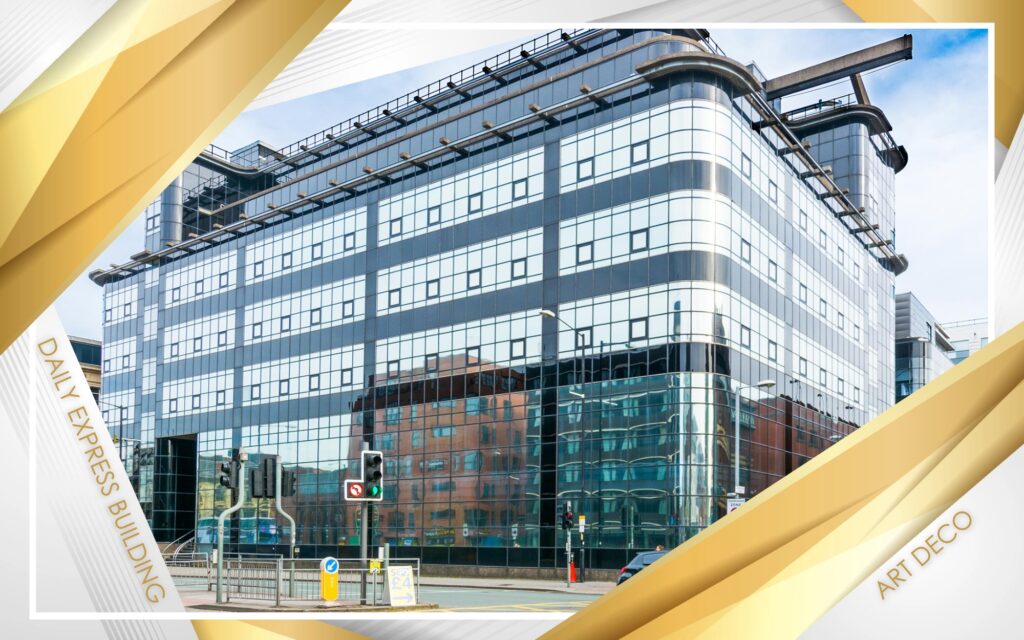Exploring the Marvels of the Art Deco Style

Art Deco is an influential architectural style that emerged in the early 20th century, reaching its peak of popularity during the 1920s and 1930s. Characterized by its sleek, geometric shapes, bold colours, and decorative detailing, Art Deco architecture exudes an aura of elegance, luxury, and modernity.
This distinctive style draws inspiration from a diverse range of sources, including ancient Egyptian and Mayan art, as well as the burgeoning industrial age. It emphasizes symmetry, streamlined forms, and the use of new materials like glass, chrome, and steel, reflecting the era’s fascination with technological progress.
One of the defining features of Art Deco buildings is the prominent use of decorative elements, such as elaborate friezes, geometric patterns, and stylized motifs, often depicting flora, fauna, and sunbursts. These intricate embellishments, combined with sleek lines and bold colour contrasts, create a sense of opulence and visual drama.
Art Deco architecture can be found in various types of buildings, from skyscrapers and theatres to hotels, cinemas, and apartment buildings. Notable examples of this Architectural style landmarks include the Empire State Building in New York City, the Chrysler Building, and the Miami Beach Architectural Historic District.
While its popularity declined after World War II, the allure of Art Deco endured, and the style experienced a resurgence in the late 20th century, with preservation efforts to protect and restore iconic Art Deco buildings worldwide. Today, the lasting impact of this design movement continues to be celebrated for its unique blend of glamour, innovation, and timeless appeal.
Notable Hallmarks of Art Deco Architecture Style
Art Deco style has left an indelible mark on architecture, and many iconic buildings around the world showcase its distinctive characteristics. Here is a list of some notable buildings designed in the Art Deco style:
- Empire State Building – New York City, USA: A towering masterpiece completed in 1931, known for its distinctive setbacks and Art Deco detailing.
- Chrysler Building – New York City, USA: An iconic skyscraper completed in 1930, featuring a sleek and ornate spire adorned with Art Deco motifs.
- Radio City Music Hall – New York City, USA: An opulent theatre completed in 1932, famous for its Art Deco interiors and the Great Stage.
- The Breakers – Palm Beach, Florida, USA: A grand mansion built in the 1920s for the Vanderbilt family, showcasing Art Deco design elements.
- Hoover Building – London, UK: A landmark building constructed in 1933, exemplifies the Art Deco style with its bold façade and decorative detailing.
- The Eastern Columbia Building – Los Angeles, USA: A striking Art Deco building completed in 1930, distinguished by its turquoise terra-cotta façade.
- Palacio de Bellas Artes – Mexico City, Mexico: A magnificent cultural centre and theatre completed in 1934, fusing Art Deco and neoclassical elements.
- The Daily Express Building – Manchester, UK: An impressive structure designed in the 1930s, featuring geometric patterns and decorative sculptures.
- The Fisher Building – Detroit, USA: A lavish office building and theatre completed in 1928, celebrated for its opulent Art Deco interiors.
- The Basilica of the National Shrine of the Immaculate Conception – Washington, D.C., USA: A monumental church with Art Deco features, completed in various stages from the 1920s to the 1950s.
These buildings stand as testaments to the enduring allure and timeless elegance of Art Deco architecture, capturing the imagination of admirers and enthusiasts worldwide.

Empire State Building
New York City, New York, USA
The Empire State Building’s architectural features are a harmonious blend of Art Deco elegance and innovative engineering, making it a timeless masterpiece in skyscraper design. Some of its notable architectural elements include:
Setbacks:
The building’s design incorporates a series of setbacks as it rises, creating a graceful tapering effect. These setbacks were a functional response to the 1916 Zoning Resolution, which required buildings to have setbacks above a certain height to allow light and air to reach street level.
Ornate Façade:
The exterior of the Empire State Building is adorned with limestone, granite, and aluminium detailing. Intricate Art Deco motifs, including geometric patterns and stylized eagles, can be found throughout the façade, adding to its grandeur.
Spire and Antenna:
The iconic spire atop the building was originally intended as a mooring mast for dirigibles, though it was never used for this purpose. The spire, along with the antenna added in the 1950s, contributes to the building’s impressive height and prominence in the skyline.
Observation Decks:
The building features two observation decks—one on the 86th floor and another on the 102nd floor. These decks offer stunning panoramic views of New York City and its surroundings, attracting millions of visitors each year.
Grand Lobby:
The Empire State Building’s Art Deco influence is evident in its grand lobby, featuring a beautiful mosaic ceiling, elegant chandeliers, and detailed marble finishes.
Overall, the architectural features of the Empire State Building exemplify the beauty, innovation, and attention to detail that define Art Deco skyscrapers, cementing its status as an enduring symbol of New York City and a beloved landmark admired by people from all corners of the globe.

Hoover Building
The Hoover Building, located in Perivale, London, is an iconic example of Art Deco architecture, known for its distinctive design and historical significance. Constructed in 1933 as the headquarters for the Hoover Company, the building showcases the quintessential features of the Art Deco style.
One of the most striking architectural elements of the Hoover Building is its streamlined and symmetrical façade, characterized by clean lines and geometric patterns. The exterior is adorned with decorative motifs, including terracotta tiles featuring Hoover’s trademark logo and industrial-inspired reliefs.
The building’s central tower, rising gracefully above the entrance, acts as a prominent focal point and is crowned with an elegant cupola. The tower’s clock and copper weather vane add to the building’s visual appeal.
Inside, the Hoover Building exhibits a grand and opulent Art Deco interior. The entrance hall features polished marble floors, elaborate light fixtures, and stylish geometric patterns, creating an atmosphere of luxury and sophistication.
Though no longer used as the Hoover Company’s headquarters, the building’s architectural significance led to its Grade II* listed status in 1980, ensuring its preservation for future generations to appreciate and enjoy. The Hoover Building remains a shining example of the Art Deco style’s enduring allure, a testament to the elegance and innovation that defined this iconic architectural era.

Palacio de Bellas Artes
Mexico City, Mexico
The Palacio de Bellas Artes, or the Palace of Fine Arts, is a magnificent cultural centre located in Mexico City, Mexico. Completed in 1934, it is a remarkable example of architectural styles blending neoclassical and Art Deco influences.
The building’s exterior showcases an impressive combination of marble and granite, adorned with intricate sculptures and reliefs that reflect the richness of Mexican art and culture. The neoclassical design is evident in the grand colonnades and the building’s elegant proportions, while Art Deco elements are apparent in the geometric patterns and decorative motifs.
The most striking feature of the Palacio de Bellas Artes is its stunning glass curtain façade, a masterpiece crafted by the Italian artist Tiffany Studios. The curtain’s vibrant colours and Art Deco patterns filter natural light into the interior, creating a mesmerizing spectacle for visitors.
The grand interior features a majestic white marble staircase, leading to the main hall adorned with lavish murals by renowned Mexican artists, such as Diego Rivera and David Alfaro Siqueiros. The auditorium’s exquisite stained-glass dome further adds to the building’s opulence and artistic allure.
Today, the Palacio de Bellas Artes serves as a cultural mecca, hosting opera, music, dance performances, and art exhibitions, making it a symbol of Mexico’s artistic heritage and an architectural gem that enchants both locals and visitors from around the world.

Chrysler Building
New York City, New York, USA
The Chrysler Building, an iconic skyscraper in New York City, stands as a stunning example of Art Deco architecture and a symbol of the city’s skyline. Completed in 1930, the building was designed by architect William Van Alen for the Chrysler Corporation, which sought to create a bold statement of corporate success and innovation.
The building’s exterior is distinguished by its gleaming stainless steel cladding, which reflects the changing light throughout the day. Its tapering shape, set with a series of setbacks, culminates in a striking spire that reaches a height of 1,046 feet (319 meters). The spire, inspired by the design of a car radiator grille, was added secretly to surpass the height of the nearby Bank of Manhattan Trust Building and claim the title of the world’s tallest building at the time of its completion.
The Art Deco detailing is prominent in the terraced crown adorned with triangular windows and the distinctive sunburst patterns that decorate the façade. Gargoyles shaped like eagle heads enhance the upper portion of the building, adding an air of grandeur and an ode to automotive designs.
Inside, the lobby boasts elegant Art Deco ornamentation, including marble walls, inlaid woodwork, and stylish geometric motifs, creating an atmosphere of timeless opulence.
The Chrysler Building remains an enduring testament to the Art Deco era’s exuberance and innovation, captivating onlookers with its graceful silhouette and ornate detailing while embodying the spirit of progress and architectural brilliance that defines New York City.

Daily Express Building
Manchester, United Kingdom
The Daily Express Building, located in Manchester, United Kingdom, is a prominent example of Art Deco architecture that exudes the style’s bold and striking characteristics. Designed by renowned architect Sir Owen Williams and completed in 1939, the building served as the headquarters of the Daily Express newspaper.
One of the most distinctive architectural features of the Daily Express Building is its sleek and streamlined façade, characterized by horizontal bands of windows and decorative elements that emphasize the building’s verticality. The use of contrasting materials, including black Vitrolite panels and white Portland stone, adds to the building’s visual impact.
The striking clock tower atop the building’s northwest corner serves as a prominent focal point and is adorned with Art Deco detailing, while the roofline features sculptural figures representing the Four Winds, contributing to the building’s artistic flair.
Inside, the building’s interior spaces showcase elegant Art Deco designs, including marble finishes, geometric patterns, and stylish light fixtures that evoke a sense of sophistication and modernity.
Though it no longer houses the Daily Express, the building’s architectural significance led to its Grade II listed status, ensuring its preservation for future generations to appreciate and enjoy. The Daily Express Building stands as a testament to the Art Deco era’s design ingenuity and remains a cherished landmark in the city of Manchester.
For more exciting news and facts, check out our website New Facts World and follow us on Instagram.



